The Artura Spider Feels Like the Car McLaren Should Have Launched
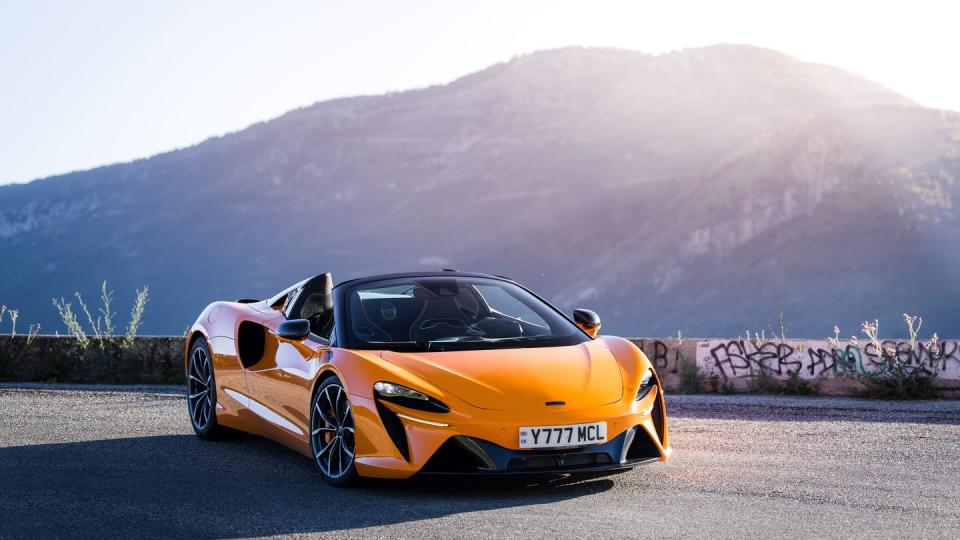
So long, Artura – we hardly knew ya. McLaren’s plug-in supercar hit so many delays both before and after going into production that it has barely reached the U.S before being improved by a new, improved version. We didn’t even manage to get one into Performance Car of the Year, and now we never will. Because although we drove the open-topped Artura Spider in Spain, all of the same mechanical changes are going to be made to the Artura Coupe. Give it a few years and the few pre-facelift Arturas to make it here could well be rare collector’s items.
As you would expect for a brand as famous for exactitude as McLaren, differences are both individually slight and collectively significant. In terms of statistics the most obvious is a slight increase in power, with the 3.0-liter turbocharged V-6 and the axial flux motor that sits between this and the twin-clutch gearbox now making a combined peak of 690 hp, a 19 hp increase on before. Anybody with an existing Artura will also be given this upgrade free of charge.
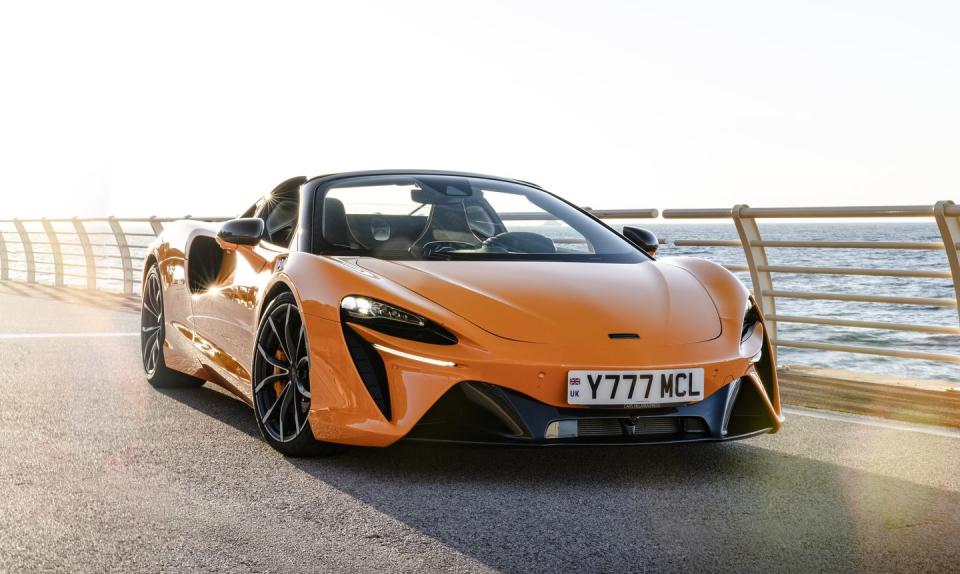
The other revisions are reserved for the 2025 cars. First is a new exhaust, answering criticism the original Artura lacked aural character, with the additional option of a sports system that can direct more engine noise into the cabin. Revised active dampers are quicker to react, a semi-solid engine mount improves responses, cooling is improved for both the V-6 and the standard carbon-ceramic brakes. There is also a new calibration for the eight-speed gearbox, this holding the electronically controlled clutches at the very edge of engagement to speed the already-rapid shift times by up to 25 percent. A second launch control mode has been added, this allowing more slip and named, with the sort of no-nonsense literalness that former McLaren boss Ron Dennis would doubtless have appreciated, Spinning Wheel Pull-Away Mode.
Choosing the Spider over the Coupe will be a pain-free decision beyond the need to fund the $24,700 difference in price. The weight penalty is just 137 pounds, and the fact both cars share the same carbon fiber tub means there is no reduction in structural strength. All suspension hardware is shared, including springs - the only changes have been made to software calibration to take account of the Spider’s increased mass and slightly higher center of gravity. The single piece retractable hard top is powers itself closed or raised in just 11 seconds and, when up, has a profile pretty much identical to the Coupe. The key difference is that the Spider’s elongated rear buttresses that run from the roof towards the rear of the car is made from clear polycarbonate to enhance over-the-shoulder visibility when the roof is down. The Coupe’s are solid.
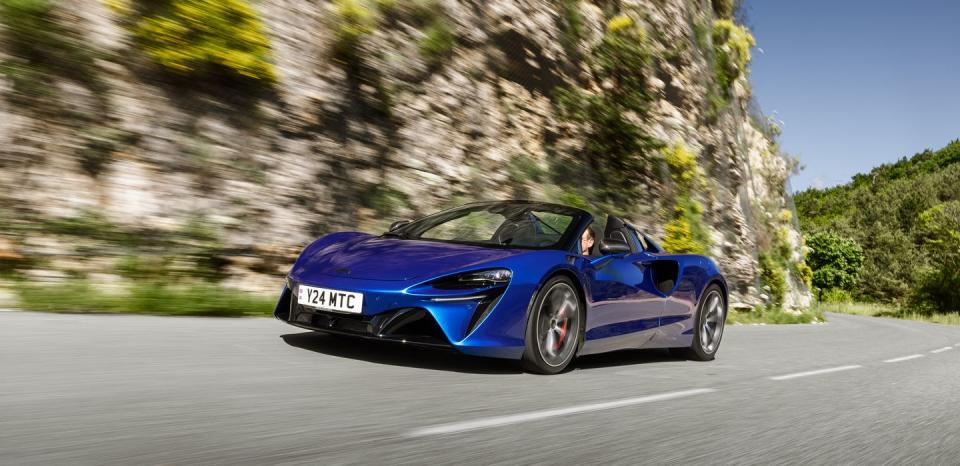
I didn’t have a Coupe for direct comparison on the media drive in France, but with the Spider’s roof raised the driving experience felt snug and Coupe-like. My test car had also the optional electrochromic glass roof panel that can be switched from dark to clear, this bringing a modest weight penalty over the standard carbon fiber and a $9400 supplement. With the roof lowered - as it was most of the time - the Artura turned breezy and exciting. Buffeting is minimized by both a powered rear deflector screen as well as ducting that directs high-speed air from the header rail.
Despite the new exhaust, the Artura still doesn’t sound especially compelling. My test car came with the $5100 Sport system, which delivered plenty of volume and muscular notes when the engine was worked hard. There was also less of the obvious induction roar I remember from the original coupe. But even with the turned-up exhaust, and the ability to listen to this without the filter of a roof, the Artura still lacks the vocal range and zinging top end of its most obvious rival, the V-6 PHEV Ferrari 296 GTS. The McLaren is big on bass, but short on treble, and the soundtrack never harmonizes to true specialness. The sports system also created a drone at constant cruising speeds with the roof raised.
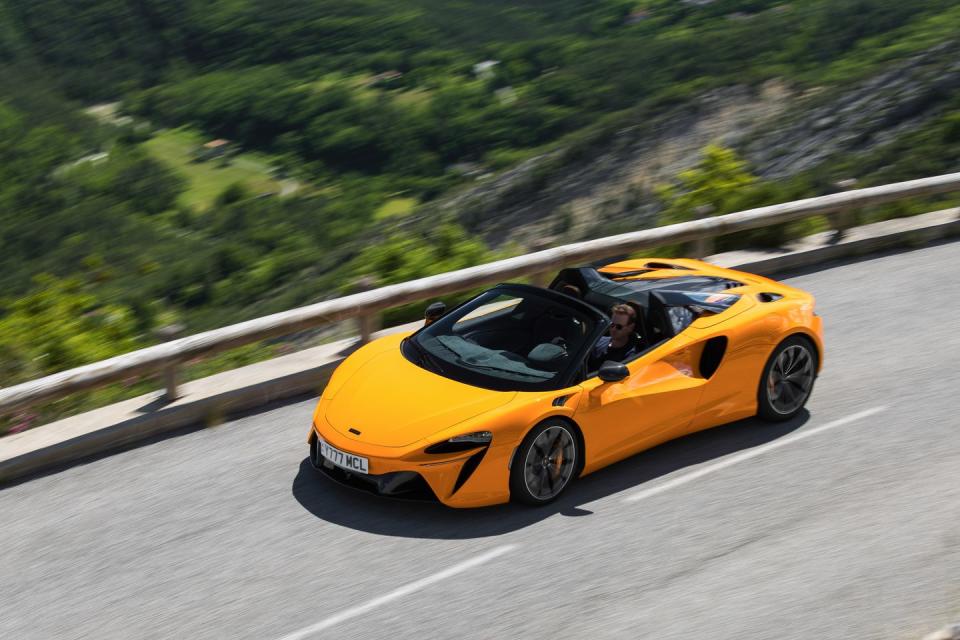
Not that you have to listen to sounds of combustion, of course. Like the Coupe, the Artura Spider offers a no-engine mode by selecting the Electric powertrain setting, one that renders it almost silent beyond a futuristic EV compliance noise to warn pedestrians of its approach. EV range is limited – no more than 11 miles – and performance from the 94 hp electric motor is correspondingly restricted. But the chance to do a low-speed lap of the streets that form the Monaco Grand Prix circuit had onlookers visibly confused by this stealthy supercar. It remains a great way for Artura owners to sneak out for early drives without their neighbors hating them.
The Hybrid mode – which switches the Spider automatically between electrical and combustion power – is easily confused. Requesting hard acceleration when the Artura is running as an EV brings an awkward pause as the engine starts and the transmission chooses a gear. Another quirk comes if trying to use manual transmission setting in Hybrid, as the gearbox defaults back to auto every time the car switches to electric power. I soon learned to move straight to the Sport powertrain mode, which keeps the V-6 running all the time.
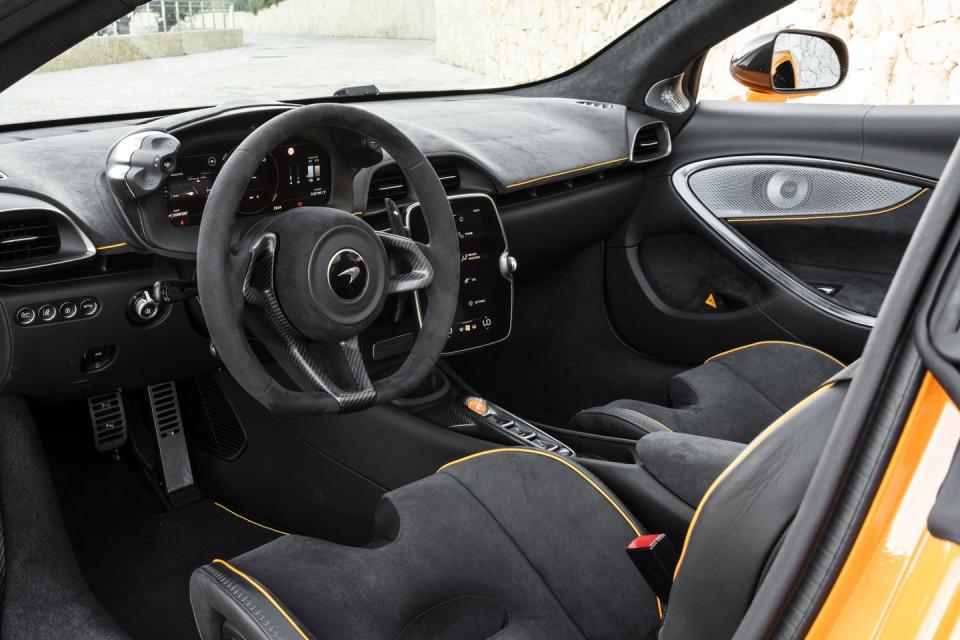
The Artura Spider is hugely fast, but not savage. At lower revs the electric motor provides instant torque to fill the small delay as the turbos build boost. Once the snails are scrolling the V-6 provides a linear rush of urge that doesn’t diminish all the way to the 8500 rpm redline. The speed of the throttle response means the Artura Spider feels more enthusiastic than the mightier but unhybridized McLarens that sit above it in the range. The reduced mass of carbon fiber over metal architecture brings advantages here, too. The more expensive Ferrari 296 GTS’s hybrid powertrain has an additional 129 hp, but the Artura Spider is 200 lbs lighter. Indeed, as execs on the launch were happy to point out, McLaren’s roadster weighs less than the rival Ferrari coupe.
As well as lightness the carbon fiber structure brings enormous strength, evident throughout the driving experience. There is no sense of body flex or unwanted movement, and ride is excellent for a supercar. The Comfort chassis mode delivers on its eponymous claim with the pliant absorption of bumps; Sport and Track increase firmness without harshness. A front-end lifter will be standard in the U.S., but even on the occasions I didn’t engage this in sufficient time before meeting one of the south of France’s many speed bumps there was no contact. Earlier McLarens bumped and often ground their way over even low obstacles, but the Artura is no harsher or more compromised than a Porsche Cayman.
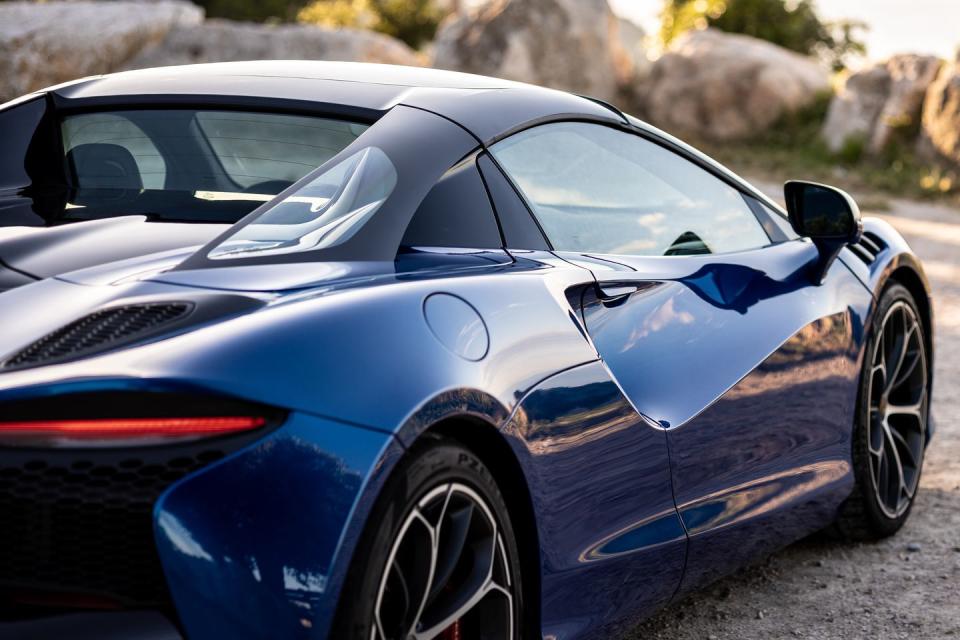
The car I drove sat on the optional track-biased Pirelli P-Zero Corsas, these generating effectively total grip on dry asphalt, only the slowest and tightest corners offering the chance to push the handling balance rearwards on power. The massive adhesion didn’t make the Spider feel dull or inert, the hydraulically-assisted steering feels great and delivers crisp responses. A chosen cornering line can be subtly altered with delicate throttle changes. I still wondered whether the lower lateral limits of the regular P-Zeros that will come as standard fitment would be offering more accessible fun at road speeds.
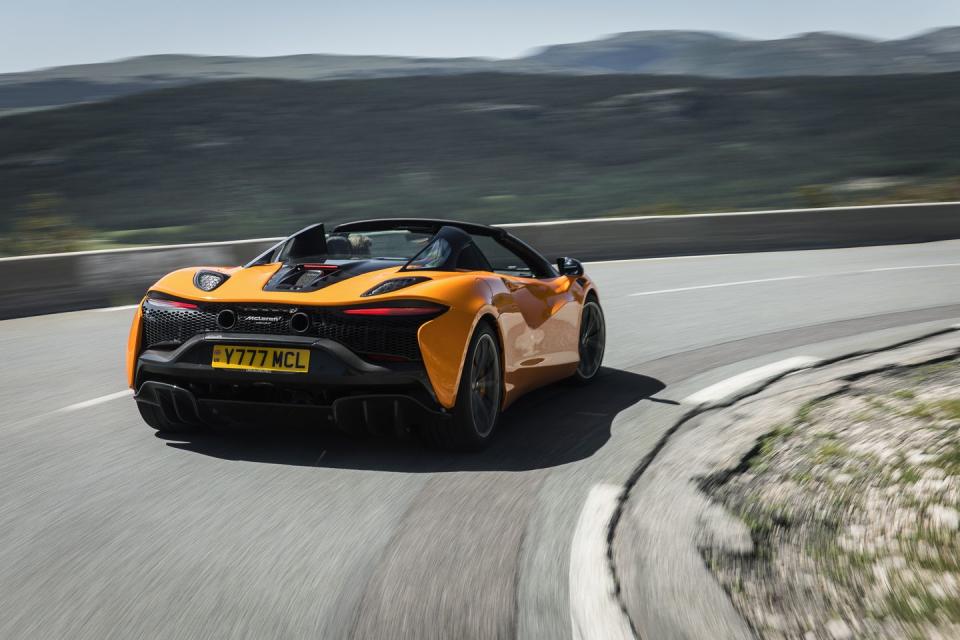
As in the Artura Coupe, McLaren offers a variable drift function... which I didn’t try on a route that consisted substantially of narrow mountain roads above altitudinous drops. But basic journalistic ethics did demand that I test the abilities of the Spinning Wheel Pull-Away Mode. It delivered as promised, although “Showboat Mode” would sum it up better.
Another slight quirk has survived from the earlier Artura – the lack of regenerative braking. The 7.4kWh on-board battery can only be recharged directly from the engine. This feels like an omission in a part-electric car, but as before McLaren’s engineers say that integrating regen with friction braking from the carbon-ceramic discs would risk compromising responses. (I was too polite to point out that Ferrari seem to have managed it with the 296.) The Spider’s brake pedal does indeed feel excellent, and the hardest abuse I could mete out on the Route Napoléon failed to soften it.
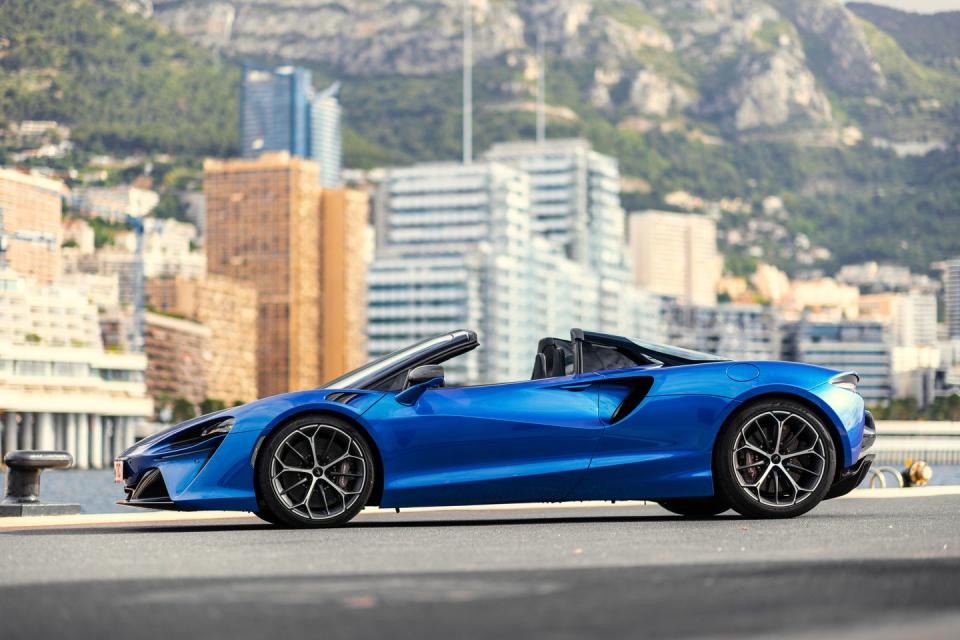
When R&T interviewed McLaren CEO Michael Leiters last month he promised that supercars would remain at the heart of the business, even as it looks towards a radical future of EVs and the possibility of a plug-in SUV. The revised Artura feels like a start on that pledge, especially in Spider form. It's sharpened and incrementally improved over the first version. Now McLaren has to do the really important bit – get cars built and delivered to customers.
You Might Also Like

 Yahoo Finance
Yahoo Finance 